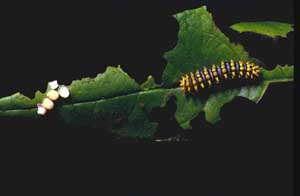|
|
 4 egg hatching DHJanzen100598.jpg high resolution
|
|
| Six days after being laid, the eggs hatch and the new first instar larva eats part of the egg shell. It is likely, but as yet unstudied, that in eating the egg shell the new larva is picking up a bacterial innoculation from the mother, bacteria that will be part of the digestive process in the gut of the larva and in the metabolism of growth with the nutrients taken up by the feeding larva. The R. lebeau larva (a.k.a. caterpillar) on the right has already grown enough to molt from the tiny first instar larva that hatched from the egg (which was a miniature version of this caterpillar) into this second instar larva (which is about 4 days old). The caterpillar is essentially a leaf-eating machine, internally designed to accumulate the reserves that will then be used by the pupa and the adult. During an instar (the period between molts) the flexible body wall expands to accomodate the developing tissues (a.k.a. growth) but the head, which contains the massive muscles that drive the leaf-cutting mandibles, is a hard capsule that cannot expand. At the time of molting from one instar to the next larger instar, the newly formed head capsule is soft and flexible at the time of molting, and expands to the larger size for the next instar before the head capsule hardens into its size and form for that instar. In essence, the body dimensions increase roughly continually (except for a pause during molting), while the head size abruptly increases four times during the five instars before pupation. This design, characteristic of the great majority of species of insects, is obviously a very different pattern of growth from that which is displayed by vertebrates or plants. | ||
back to lecture slides
or skip to: